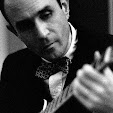All images, copyright 2014 by Nick Rossi
Showing posts with label eero saarinen. Show all posts
Showing posts with label eero saarinen. Show all posts
Thursday, November 13, 2014
Tuesday, August 20, 2013
Irving Harper (2013)
George Nelson Clock reproduction by Verichron, 2013
Online ad, Modernica, 2013
Print ads, Howard Miller Clock Company, 1956
Debut of the Herman Miller logo, 1947, logo by Irving Harper for George Nelson Design
For further reading, I highly recommend this article as well as this one.
Labels:
design,
eames,
eero saarinen,
George Nelson,
industrial design,
Irving Harper,
new york,
sculpture
Tuesday, April 30, 2013
The MIT Chapel (1955)
The MIT Chapel, design by Eero Saarinen 1953-1956, photo by editor 2013
Eero Saarinen, 1950
Saarinen at mid-century had a string of notable achievements and was a known quantity within the design community. His collaboration with Charles Eames resulted in recognition by the MOMA in New York City as well as their participation in the Case Study House program in California (Number 9 to be exact). Eero had spent a good portion of the 1940s working in his father's architecture firm but after the death of the elder Saarinen in July of 1950, the younger launched a shop of his own. At just 85 years old in that same year, MIT was something of a young university - particular compared to its many esteemed and much longer in the tooth neighbors. In some ways, it lacked the traditions that a school such as Harvard had by that time, which may account for it's more forward-thinking artistic engagements.
Interior, The MIT Chapel, photo by editor 2013
Podium sculpture, Harry Bertoia, The MIT Chapel, photo by editor 2013
The resulting building remains as stunning today as I expect it was on it's dedication day. Saarinen created a haven: a place of remarkable peace and tranquility. The brick, wood, and marble evokes the pre-Christian world refashioned into something modern yet timeless. His use of light - both natural and artificial - is masterful. The final touches are both contributions from other artists. Harry Bertoia, who like Eames had first met Eero at Cranbrook University, provided the metal sculpture which descends from the ceiling to the base of the podium/altar. Other writers have focused on the speculative literal meaning of the piece, but it is simply a beautiful accent that deflects the incoming light in a hundred different direction. Interpret it as you wish. Theodore Roszak designed the abstract bell tower or spire which was added to the building in 1956.
The MIT Chapel is a singular structure: devoid of any denomination, yet vibrantly spiritual and a shrine to solace. I would expect - if not hope - that its chairs have been full these past couple of weeks.
Labels:
architecture,
boston,
eames,
eero saarinen,
Harry Bertoia,
sculpture,
travel
Friday, June 26, 2009
Una sull'altra (1969)
Dig this clip from Lucio Fulvi's 1969 thriller.
Right, I know. Yes, that's foxy Marisa Mell pulling the change-r-oo in the ladies room. And, yes, that's Riz Ortolani providing a score that sounds like Zal Yanovsky jamming with Oliver Nelson's orchestra. But the real star of the clip is Eero Saarinen's TWA Flight Center at New York's JFK airport. There are a couple of great shots of terminal back when it was first a functioning building. Just beautiful.
I did have the opportunity to pass through the hollowed halls of this architectural masterpiece just once. It was 1998 and I was en route to Barcelona, Spain experiencing an unexpected lay-over in the terminal. It was remarkably well preserved and I, frankly, thought I was in a dream. When I think about the events of the past decade or so which really opened my eyes to great design, this was certainly one of the most important ones.
Of course the happy ending to this post is not only can you now fly out/in to Terminal 5 again thanks to JetBlue, but you can also get your shoes shined there by my favorite San Francisco-based shine company, A. Shine & Co. Book your flight now!
Subscribe to:
Posts (Atom)


























